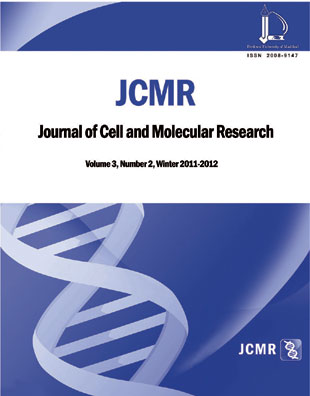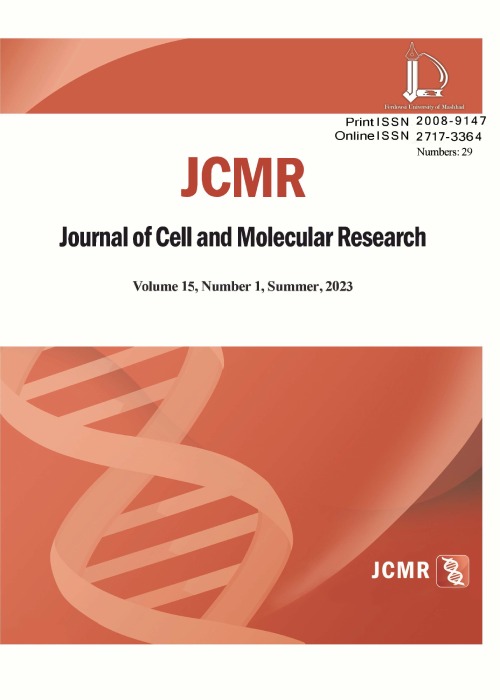فهرست مطالب

Journal of Cell and Molecular Research
Volume:3 Issue: 2, Winter and Spring 2011
- تاریخ انتشار: 1391/08/16
- تعداد عناوین: 6
-
-
Page 43Asafoetida is the dried latex exuded from the living underground rhizome or tap root of Ferula assafoetida. Antibacterial characteristic of asafoetida was shown using the circular zone diameter of bacterial growth inhibition by disk-diffusion method on two gram positive and three gram negative bacteria. Then, the bacterial genomic DNA damage, induced by F. assafoetida latex, was demonstrated using the comparison of random amplification of polymorphic DNA profiles generated by polymerase chain reaction of control and treated bacterial genomes. The results showed that the number of primers that produced bands in each bacterium were higher in control samples compared to those treated with asafoetida. This and the absence or presence of bands between controls and treatments confirm rearrangements and DNA damage in the priming binding sites of bacterial genome.Keywords: Antibacteria, Asafoetida, DNA Polymorphism, DNA damage
-
Page 51Essential oils, with plant origin, have been of special attention in cancer research during recent years. Despite many reports on cytotoxic effects of plants from genus salvia, the potential application of their extracts in cancer therapy remains to be assessed in more precise and detailed examinations on the main cause of such effects. In this research, the cytotoxic effect and anticancer activity of essential oils from S. leriifolia on human Transitional Cell Carcinomaa (TCC) were studied in vitro. The antiproliferative activity of essential oils on TCC and L929 (control) cells was determined by 3-[4, 5-dimethylthiazol-2-yl]-2, 5-diphenyl tetrazolium bromide (MTT) assay, by which the mitochondrial dehydrogenase enzyme activity is assessed based on reduction of the MTT to purple. The amount of essential oils to induce 50% of cells to die, designated as IC50, was determined by repeated experiments and application of different doses of the essence. The established IC50 on TCC cells for the essences extracted in two different years of 2006 and 2008 and from two locations of Bajestan and Neyshabour was respectively as: 466 and 250 μg/ml, and 233 and 212 μg/ml. S. leriifolia essential oil did not show any detectable effect on L929 cells in this range of concentration. S. leriifolia essential oil has inhibitory effects on the growth of both TCC and normal L929 cell lines, although the effective concentrations were significantly different in these cell lines. This effect was dose dependent.Keywords: S. leriifolia, essential oil, cytotoxic, MTT
-
Page 57Microglia, the sentries of the brain, is highly implicated in neurodegeneration as in neuroprotection. Chronic microglial activation endangers neuronal survival through the release of various potentially neurotoxic mediators including Nitric Oxide (NO). Thus, negative regulators of microglial activation have been considered as potential therapeutic candidates to target neurodegeneration, such as those in Alzheimer’s and Parkinson’s diseases and even in chronic epileptic syndromes. Bromelain, a mixture of cysteine proteases, derived from pineapple stem, has been reported to have anti-inflammatory and immunomodulatory effects. Neonatal rat primary microglial cells were isolated from the brain according to the Floden’s method. The purity of the cultures was determined by immunostaining with an OX-42 antibody which showed a purity greater than 95%.The activation profile of microglia was investigated by determining the effects of Bromelain (1, 10, 20, 30, 40 and 50 μg/ml) on the level of neurotoxin, NO, mitochondrial activity and morphological changes in treated microglia with lipopolysaccharide (LPS) (1μg/ml), as an endotoxin. Our results showed that pretreatment of primary rat microglia with bomelain (30 μg/ml), decreased the production of NO induced by LPS (1μg/ml) treatment in a dose-dependent manner, which prevented the deramification of microglia and its phagocytic morphology. Moreover, bromelain does not show cytotoxicity at any of the applied doses, suggesting that the anti-inflammatory effects of bromelain are not due to the cell death. In conclusion, Bromelain reduces the NO synthesis in vitro by potentially exerting its anti-inflammatory effects. Bromelain naturally found in pineapple stem, can be considered as a useful agent for neuroprotection and alleviation of symptoms in neurodegenerative diseases.Keywords: Microglia, Bromelain, CNS inflammation, NO, Neurodegeneration
-
Page 66Foot-and-mouth disease (FMD) is a major cause of endemic outbreaks in livestock in Iran. In this study, clinical field samples of foot-and-mouth disease virus were collected from an outbreak in Khorasan Razavi Province during April and August of 2010, and subjected to indirect sandwich ELISA and RT-PCR. The viral serotype circulating during the period was confirmed to be type O. The virus was then genetically characterized for its complete P1 genomic sequences to compare with nine corresponding nucleotide sequences of representative foot-and-mouth disease viruses (FMDVs) registered in the GenBank. The P1-coding region was 2208 nucleotides in length with 736 encoded amino acid residues. Phylogenetic analysis revealed two major lineages of A (with three additional clusters) and B. Iranian field isolate was grouped within cluster I, most closely related to Pakistani strains PAK/39/2008 and PAK/29/2008 sharing 98.37 and 98.1% amino acid identity, respectively, demonstrating the close epidemiological links between countries in the region. In contrast, our isolate showed low amino acid identity with Italian isolate O-2-Brescia (93.48%) and Argentinean isolate O1 Caseros (93.75%). Based on multiple sequence alignments, comparison of sequences showed that the characteristic amino acid mutations were found in the VP1, VP2 and VP3 proteins of isolated virus. This article is the first to report on the complete P1 genomic characterization of type O FMDV circulating in Iran
-
Page 75Transgenic and non transgenic Nicotiana tabacum L (cultivar Wisconsin) containing Ri T-DNA were treated with 0, 0.2 and 0.4 mgL-1 GA3 in Murashig and Skoog medium. Some physiological parameters including shoot length, leaf area, number of auxiliary bud, fresh and dry weight, number and length of trichomes were measured. Shoot length, fresh weight and dry weight were increased but number of trichome did not change by GA3 treatment. Chlorophyll, carotenoid and anthocyanin pigments of leaf were decreased. Auxin and gibberellic acid content of leaf and root were also measured. Exogenous GA3 increased root auxin in the transgenic plants while it did not change in shoot. GA3 treatment increased gibberellin content in both of root and shoot.Keywords: auxin, gibberellic acid, growth parameters, Nicotiana tabacum
-
Page 81In this study the original mitotic chromosome counts are presented for 5 Onobrychis species of O. sect. Onobrychis in Iran, 2n = 2x = 14 for O. persica, 2n = 4x = 28 for O. viciifolia, 2n = 4x = 28 for O. altissima, 2n = 2x = 14 for O. shahpurensis and 2n = 2x = 14 for O. sosnovskyi. The basic chromosome numbers of all studied taxa are consistent with the proposed base number of x = 7. In addition, the meiotic chromosome number of 2n = 4x = 28 for O. viciifolia and O. altissima and of 2n = 2x = 14 for O. sosnovskyi and O. persica are reported here. This study is the first report on the chromosome counts of O. persica and O. shahpurensis. All studied taxa displayed regular bivalent pairing and chromosome segregation at meiosis. However, some abnormalities were observed in the taxa are discussed.Keywords: chromosome number, Fabaceae, meiotic behavior, mitosis, Onobrychis, Iran


